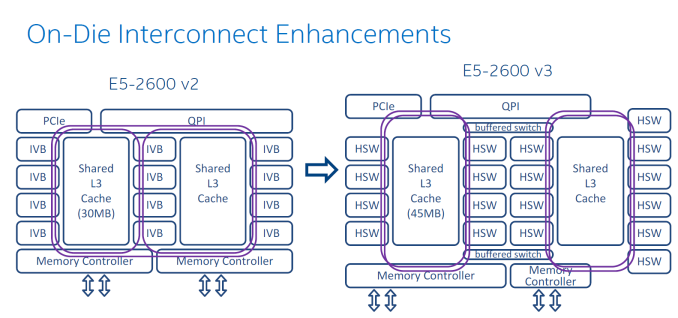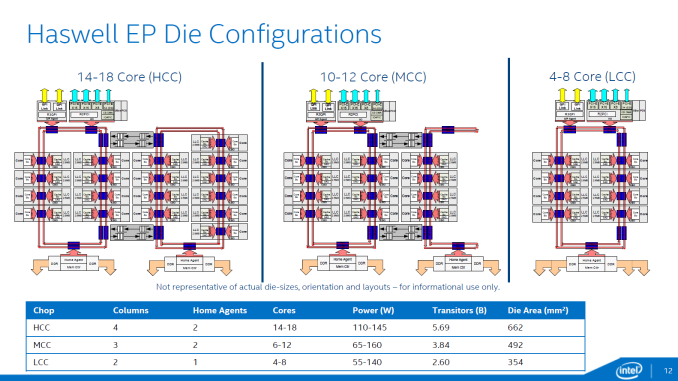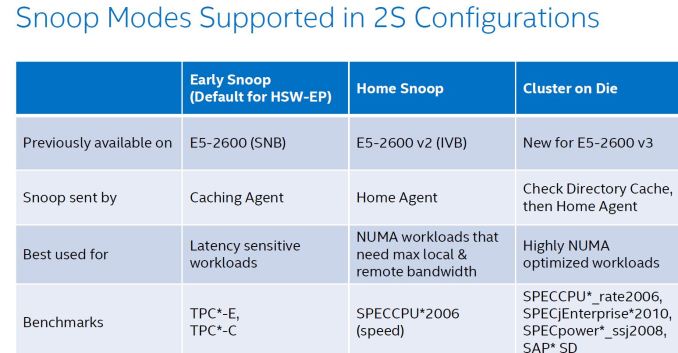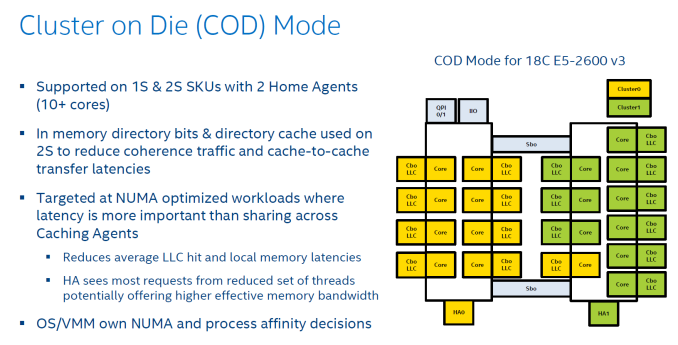Intel Xeon E5 Version 3: Up to 18 Haswell EP Cores
by Johan De Gelas on September 8, 2014 12:30 PM ESTThe Magic Inside the Uncore
We were already been spoiled by Ivy Bridge EP as it implemented a pretty complex uncore architecture. With Haswell EP, the communication between memory controllers, LLC, and cores has become even more intricate.
The Sandy Bridge EP CPU consisted of two columns of cores and LLC slices, connected by a single ring bus. The top models of the Ivy Bridge EP had three columns connected by a dual ring bus, with outer and inner rings as pictured above. The rings move data in opposite directions (clockwise/counter-clockwise) in order to reduce latency by allowing data to take the shortest path to the destination. As data is brought onto the ring infrastructure, it must be scheduled so that it does not collide with previous data.
The 14 and 18 core SKUs now have four columns of cores and LLC slices, and as a result scheduling gets very complicated. Intel has now segregated the dual ring buses and integrated two buffered switches to simplify scheduling. It's somewhat comparable with the way an Ethernet switch divides a network into segments. Each ring can act independently, and as result the effective bandwidth increases, which is especially helpful when FMA/AVX instructions are working on 256-bit chunks of data.
In total there are now three different die configurations. The first one, from four up to eight cores, is very similar to the lower count Ivy Bridge EPs. It has one dual ring, two columns of cores, and only one memory controller. The LLC cache is smaller on this die and has a lower latency.
The second configuration supports 10-12 cores and is a smaller version of the third die configuration that we described above. These dies have two memory controllers. The blue points indicate where data can jump onto the ring buses. Note that the die configurations are not symmetrical. For example an 18-core CPU has 8 cores (4-4) and 20MB LLC on one side, with 25MB LLC and 10 cores on the other. The middle configuration drops six to eight of the cores on the right ring, with an associated amount of LLC.
Data/instructions of one core are not stored in the adjacent cache slice. This could have lowered latency in some cases but it can create hotspots. Data is stored based on the physical address, ensuring all LCC cache slices are uniformly accessed. Transactions take the shortest path.
Rings are one of the entities that work on a separate voltage and frequency, just like cores. So if more I/O or coherency messaging is going on than processing, power can be dynamically allocated to speed up the rings.
Cache Coherency
The Home Agents are used for cache coherency and requests to DRAM. In dies that have two memory controllers, each home agent will use two channels. In dies that have one memory controller, each home agent will address four channels. While the smaller dies have faster LLC caches, Intel estimates that the second memory controller will extract 5% to 10% more bandwidth.
The two socket Haswell EP supports three snooping modes as you can see below. The first, Early Snoop, was available starting with Sandy Bridge EP models. With Ivy Bridge EP a second mode, Home Snoop, was introduced. Haswell EP now adds a third mode, Cluster on Die.
These snoop modes can be set in the BIOS.
Ivy Bridge used home snooping and had a directory in memory. The latest Xeon has directory caches (about 14KB) in each Home Agent. This directory cache keeps track of the contested cache lines to lower cache-to-cache transfer latencies. Another result is that directory updates in memory are less frequent and there are less broadcast snoops. Cluster On Die mode is the latest addition to the coherency protocols.
Cluster On Die can be understood as if you split the CPU and LLC into two parts that behave like two CPUs in NUMA. The OS is presented two affinity domains. As a result, the latency of LLC is lowered, but the hitrate is slightly lower. However if your application is NUMA aware, data and instructions are kept close to the part of the CPU that is processing them.
Higher QPI speeds, also notice the "COD" and "Early snoop" option.
And finally, QPI has been sped up to 9.6 GT/s, from 8 GT/s (as you can see in the BIOS shot).
More improvements
The list of (small) improvements is long and we have not been able to test all of them out. But here is an overview of what also improved
- Lower VM Entry/exit latency. The latency of going and forth to the Hypervisor has been improved compared to Westmere. Sandy Bridge slightly increase this compared to Westmere.
- VMCS shadowing. De VM Control Structure can be exposed to hypervisors running on top of the main hypervisor. So you get VT-x inside your nested hypervisor
- EPT Access and Dirty Bits. This makes it easier to move memory pages around, which is essiential for Live Migration / vMotion
- Cache monitoring (CMT) & allocation technology (CAT). CMT allow you to "measure" if a certain Virtual machine hogs the LLC . In certain SKUs is possible have control over the placement of data in the last-level cache.
Most of the improvements listed are specific for virtualized servers. However, cache allocation monitoring is also available for "native" OS.















85 Comments
View All Comments
shodanshok - Tuesday, September 16, 2014 - link
Hi,Please note that the RWT article you are endlessy posting is 10 (TEN!) years ago.
SGI tell the extact contrary of what you reports:
https://www.sgi.com/pdfs/4227.pdf
Altrix UV systems are shared memory system connecting the various boards (4-8 sockets per board) via QPI and NUMAlink. They basically are a distribuited version of your beloved scale-up server. After all, maximum memory limit is 16 TB, which is the address space _a single xeon_ can address.
I am NOT saying that commodity X86 hardware can replace proprietary, big boxes in every environment. What I am saying it that the market nice for bix unix boxes is rapidly shrinking.
So, to recap:
1) in an article about Xeon E5 (4000$ max) you talk about the the mighty M7 (which are NOT available) with will probably cost 10-20X (and even T4/T5 are 3-5X);
2) you speak about SPECInt2006 conveniently skipping about anything other that throughput, totalling ignoring latency and per-thread perf (and event in pure throughput Xeons are very competitive at a fraction of the costs)
3) you totally ignore the fact that QPI and NUMAlink enable multi-board system to act as a single one, running a single kernel image within a shared memory environment.
Don't let me wrong: I am not an Intel fan, but I must say I'm impressed with the Xeons it is releasing since 4 years (from Nehalem EX). Even their (small) Itanium niche is at risk, attacked by higher end E7 systems.
Maybe (and hopefully) Power8 and M7 will be earth-shattering, but they will surely cost much, much more...
Regards.
Brutalizer - Friday, September 19, 2014 - link
This is folly. The link I post where SGI says their "Altix" server is only for HPC clustered workloads, applies also today to the "Altix" successor: the "Altix UV". Fact is that no large Unix or Mainframe vendor has successfully scaled beyond 32/64 sockets. And now SGI, a small cluster vendor with tiny resources, claims to have 256 socket server, with tiny resources compared to the large Unix companies?? Has SGI succeeded where no one else has, pouring decades and billions of R&D?As a response you post a link where SGI talks about their "Altix UV", and you claim that link as a evidence that the Altix UV server is not a cluster. Well, if you bothered to read your link, you would see that SGI has not change their viewpoint: it is only for HPC clustered workloads. For instance, "Altix UV" talks about MPI. MPI is only used in clusters, mainly for number crunching. I have worked with MPI in scientific computations, so I know this. No one would use MPI in a SMP server, such as the Oracle M7. Anyone talking about MPI, is also talking about clusters. For instance, enterprise software such as SAP does not use MPI.
As a coup de grace, I quote text from your link about the latest "Altix UV" server:
"...The key enabling feature of SGI Altix UV is the NUMAlink 5 interconnect, with additional performance characteristics contributed by the on-node hub and its MPI Offload Engine (MOE)...MOE is designed to take MPI process communications off the microprocessors, thereby reducing CPU overhead and lowering memory access latency, and thus improving MPI application performance and scalability. MOE allows MPI tasks to be handled in the hub, freeing the processor for computation. This highly desirable concept is being pursued by various switch providers in the HPC cluster arena;
...
But fundamentally, HPC is about what the user can achieve, and it is this holy quest that SGI has always strived to enable with its architectures..."
Maybe this is the reason you will not find SAP benchmarks on the largest "Altix UV" server? Because it is a cluster.
But of course, you are free to disprove me by posting SAP benchmarks on a large Linux server with 10.000s of cores (i.e. clusters). I agree that if that SGI cluster runs SAP faster than a SMP 32-socket server - then it does not matter if SGI is cluster or not. The point is; clusters can not run all workloads, they suck at Enterprise workloads. If they can run Enterprise workloads, then I change my mind. Because, in the end, it does not matter how the hardware is constructed, as long as it can run SAP fast enough. But clusters can not.
Post SAP benchmarks on a large Linux server. Go ahead. Prove me wrong when you say they are not clusters - in that case they would be able to handle non clustered workloads such as SAP. :)
shodanshok - Friday, September 19, 2014 - link
Brutalizer, I am NOT (NOT!!!) saying that x86 is the best-of-world in scale-up performance. After all, it remain commodity hardware, and some choices clearly reflect that. For example, while Intel put single-image systems at as much as 256 sockets, the latency induced by the switchs/interconnect surely put the real number way lower.What I am saying in that the market that truly need big Unix boxes is rapidly shrinking, so your comment about how "mediocre" is this new 18-core monster are totally off place.
Please note that:
1) Altrix UV are SHARED MEMORY systems built out of clusters, where the "secret sauce" is the added tech behind NUMAlink. Will SAP run well on these systems? I think no: the NUMAlinks add too much latency. However, this same tech can be used in a number of cases where big unix boxes where the first choice (at least in SGI words, I don't have a similar system (unfortunately!) so I can't tell more;
2) HP has just released the SAP HANA benchmarks for 16 sockets Intel E7 in scale-up configuration (read: single system) and 12/16 TB of RAM
LINK1 :http://h30507.www3.hp.com/t5/Converged-Infrastruct...
LINK2: http://h30507.www3.hp.com/t5/Reality-Check-Server-...
LINK3: http://h20195.www2.hp.com/V2/GetPDF.aspx%2F4AA5-14...
3) Even at 8 sockets, the Intel systems are very competitive. Please read here for some benchmarks: http://www.anandtech.com/show/7757/quad-ivy-brigde...
Long story short: an 8S Intel E7-8890 (15 cores @ 2.8 GHz) beat an 8S Oracle T5-8 (16 cores @ 3.6 GHz) by a significant margin. Now think about 18 Haswell cores...
4) On top of that, event high-end E7 Intel x86 systems are way cheaper that Oracle/IBM box, while providing similar performances. The real differentation are the extreme RAS features integrated into proprietary unix boxes (eg: lockstep) that require custom, complex glue logic on x86. And yes, some unix boxes have impressive amount of memory ;)
5) This article speak about *Haswell-EP*. They are one (sometime even two...) order of magnitude cheaper that proprietary unix boxes. So, why on earth in each Xeon article you complain about how mediocre is that technology?
Regards.
Brutalizer - Monday, September 22, 2014 - link
I hear you when you say that x86 has not the best scaleup performance. I am only saying that those 256-socket x86 servers you talk of, are in practice, nothing more than a cluster. Because they are only used for clustered HPC workloads. They will never run Enterprise business software as a large SMP server with 32/64 sockets - that domain are exclusive to Unix/Mainframe servers.It seems that we disagree on the 256-socket x86 servers, but agree on everything else (x86 are cheaper than RISC, etc). I claim they can only be used as clusters (you will only find HPC cluster benchmarks). So, those large Linux servers with 10.000 cores such as SGI Altix UV, are actually only usable as clusters.
Regarding HP SAP HANA benchmarks with the 16-socket x86 server called ConvergedSystem 9000; it is actually a Unix Superdome server (a RISC server) where HP swapped all Itanium cpus to x86 cpus. Well, it is good that there are soon 16-sockets Linux servers available on the market. But HANA is a clustered database. I would like to see the HP ConvergedSystem server running non clustered Enterprise workloads - how well would the first 16-socket Linux server perform? We have to see. And then we can compare the fresh Linux 16-socket server to the mature 32/64-socket Unix/Mainframe servers in benchmarks and see which is fastest. A clustered Linux 256-socket server sucks on SMP benchmarks, it would be useless.
Brutalizer - Monday, September 22, 2014 - link
http://www.enterprisetech.com/2014/06/02/hps-first..."...The first of several systems that will bring technologies from Hewlett-Packard’s Superdome Itanium-based machines to big memory ProLiant servers based on Xeon processors is making its debut this week at SAP’s annual customer shindig.
Code-named “Project Kraken,” the system is commercialized as the ConvergedSystem 900 for SAP HANA and as such has been tuned and certified to run the latest HANA in-memory database and runtime environment. The machine, part of a series of high-end shared memory systems collected known as “DragonHawk,” is part of a broader effort by HP to create Superdome-class machines out of Intel’s Xeon processors.
...
The obvious question, with SAP allowing for HANA nodes to be clustered, is: Why bother with a big NUMA setup instead of a cluster? “If you look at HANA, it is really targeting three different workloads,” explains Miller. “You need low latency for transactions, and in fact, you can’t get that over a cluster...."
TiGr1982 - Tuesday, September 9, 2014 - link
Our RISC scale-up evengelist is back!That's OK and very nice, nobody argues, but I guess one has to win a serious jackpot to afford one of these 32 socket Oracle SPARC M7-based machines :)
Jokes aside, technically, you are correct, but Xeon E5 is obviously not about the very best scale-up on the planet, because Intel is aiming more at a mainstream server market. So, Xeon E5 line resides in a totally different price range than your beasty 32 socket scale-up, so what's the point of writing about SPARC M7 here?
TiGr1982 - Tuesday, September 9, 2014 - link
Talking Intel, even Xeon E7 is much lower class line in terms of total firepower (CPU and RAM capability) than your beloved 32 socket SPARC Mx, and even Xeon E7 is much cheaper, than your Mx-32, so, again, what's the point of posting this in the article about E5?Brutalizer - Wednesday, September 10, 2014 - link
The point is, people believes that building a huge SMP server with as many as 32-sockets is easy. Just add a few of Xeon E5 and you are good to go. That is wrong. It is exponentially more difficult to build a SMP server than a cluster. So, no one has ever sold such a huge Linux server with 32-sockets. (IBM P795 is a Unix server that people tried to compile Linux for, but it is not Linux server, it is a RISC AIX server)TiGr1982 - Wednesday, September 10, 2014 - link
Well, I comprehend and understand your message, and I agree with you. Huge SMP scale-up servers are really hard to build, mostly because of the dramatically increasing complexity of the problem to implement the REALLY fast (both in terms of bandwidth and latency) interconnect between sockets in case when socket count grows considerably (say, up to 32), which is really required in order to get the true SMP machine.I hope, other people get your message too.
BTW, I remember you already posted this kind of statements in the Xeon E7 v2 article comments before :-)
Brutalizer - Monday, September 15, 2014 - link
"...I hope, other people get your message too...."Unfortunately, they dont. See "shodanshok" reply above, that the 256 socket xeon servers are not clusters. And see my reply, why they are.